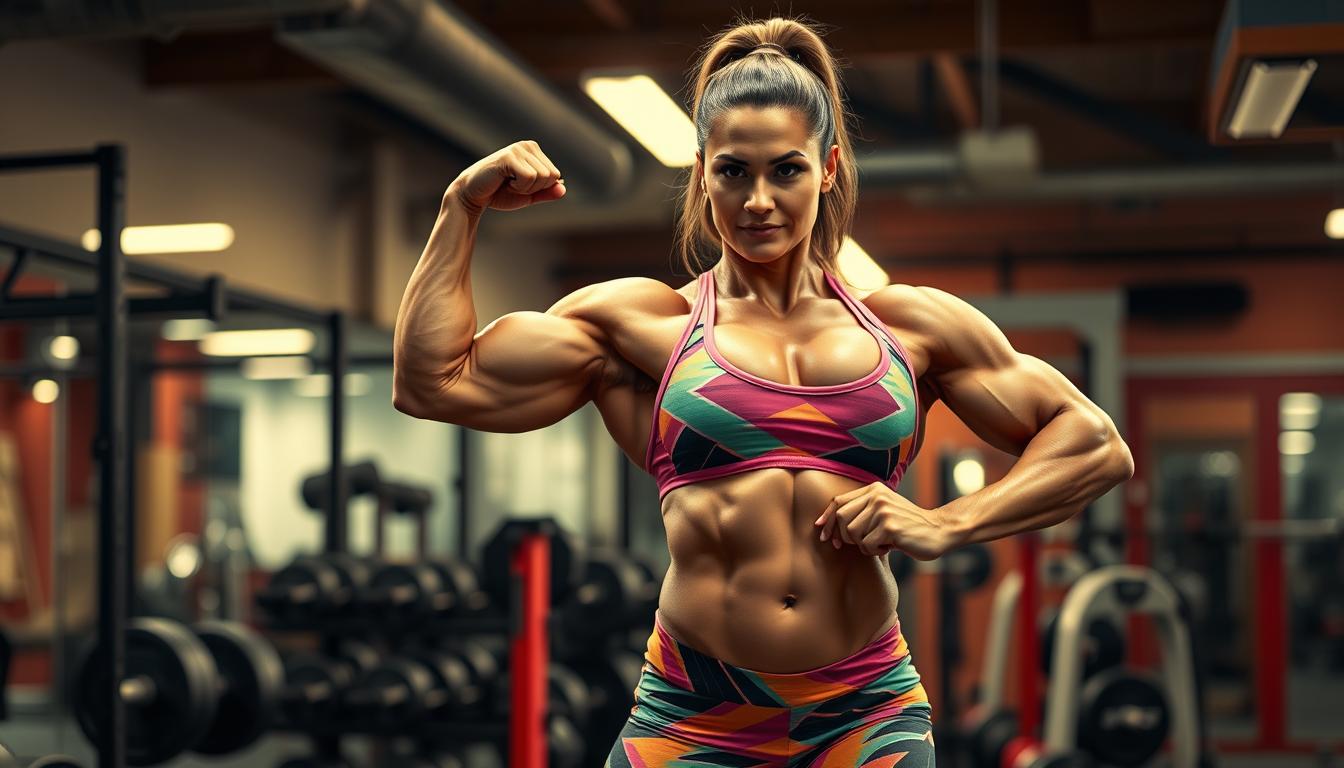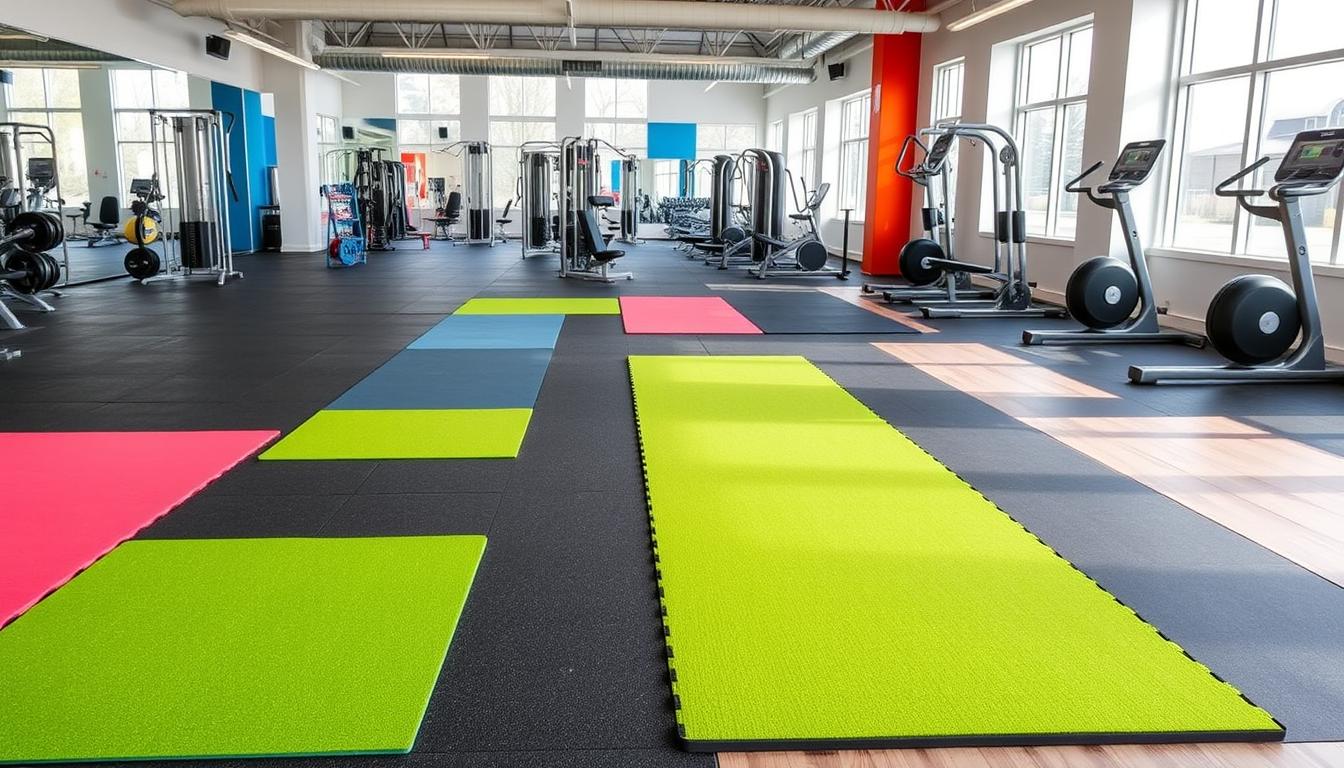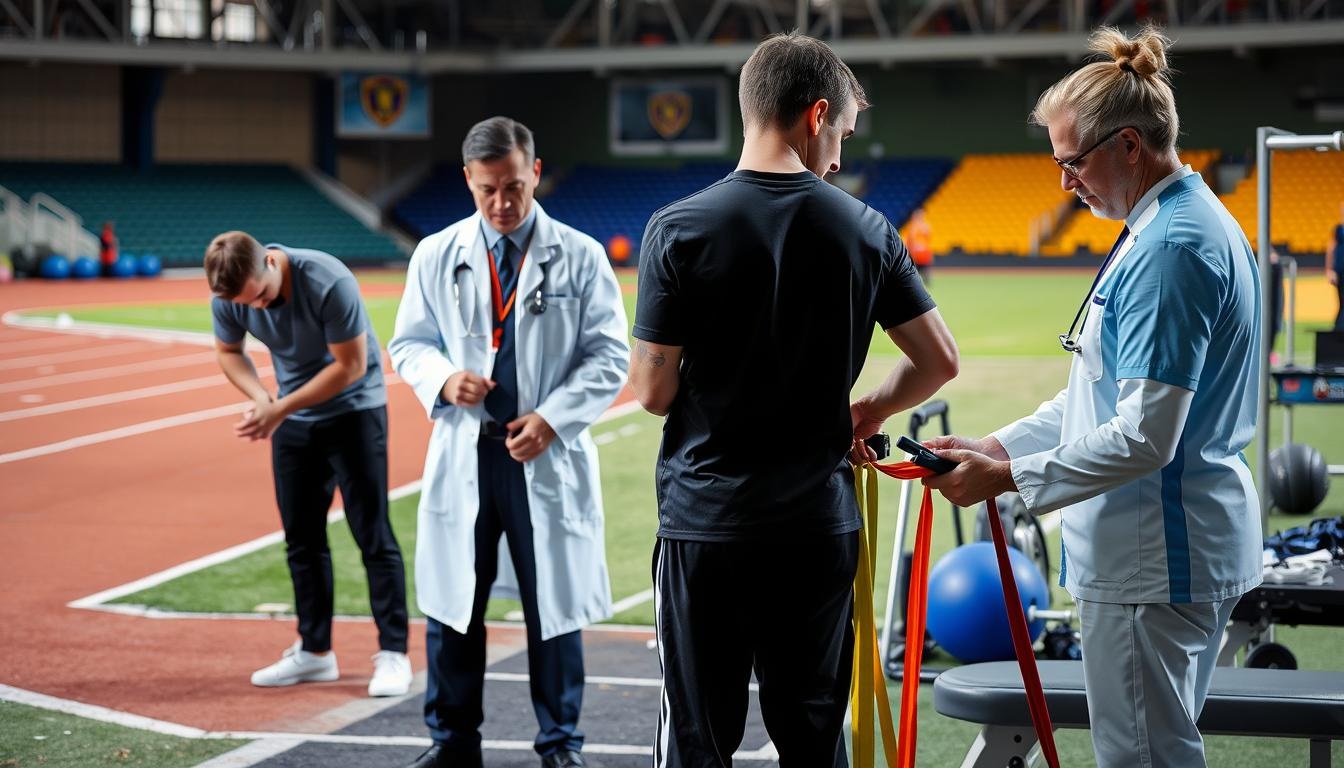Beginner Gym Workout Plan : Starting at the gym can feel scary, but it doesn’t have to be. This beginner’s gym workout plan is here to help you. It’s designed to make your journey to fitness easy and fun.
I used to be scared of the gym too. But I learned how amazing exercise can be. Now, I want to show you that anyone can love the gym, even if you’re new.
You’ll learn all about a great workout routine in the next pages. We’ll cover setting goals, doing strength training, and cardio. You’ll also find out how to plan your week, warm up right, and track your progress.
So, if you’re new to the gym or tried it before but didn’t like it, get ready for a change. You’ll get stronger, healthier, and more confident. With the right help and effort, you can become the best version of yourself, one workout at a time.
Table of Contents
Understanding Your Fitness Goals
Setting clear and realistic fitness goals is key for entry-level strength training and a good newbie fitness plan. Your goals could be to boost health, build muscle, or lose weight. Knowing what you want will guide your gym routine and keep you motivated.
Setting Realistic Expectations
As a beginner, aim for goals that match your fitness level and lifestyle. Don’t set high targets that might make you feel frustrated or give up. Start with small steps, like walking more or doing two strength workouts a week. Celebrate each small win to keep you going.
Short-term vs. Long-term Goals
- Short-term goals (4-8 weeks): These could include being able to perform a certain number of bodyweight squats or planking for a specific duration.
- Long-term goals (6 months to 1 year): Examples might include training for a 5K run or building enough strength to lift heavier weights.
Having both short-term and long-term goals helps keep you motivated. Check your progress often and tweak your goals as needed. This keeps your workout plan both challenging and achievable.
“The secret of getting ahead is getting started. The secret of getting started is breaking your complex overwhelming tasks into small manageable tasks, and then starting on the first one.” – Mark Twain

Understanding your fitness goals and setting realistic expectations will help you succeed in your newbie fitness plan. Remember, the journey is as important as the end goal. Enjoy the process and celebrate your progress.
Essential Gym Equipment for Beginners
Starting your fitness journey? Knowing the key gym equipment is vital. It helps you reach your goals. From weights and machines to cardio gear, learning how to use them is key. It sets you up for success in your beginner’s weight workout and gym workout schedule for starters.
Weights and Resistance Equipment
Weight training is great for building strength and muscle. Beginners should know about these essential tools:
- Dumbbells: Versatile free weights that target specific muscle groups.
- Barbells: Allow for compound exercises that engage multiple muscle groups simultaneously.
- Weight Machines: Offer guided movement patterns and stability, making them ideal for beginners.
- Resistance Bands: Provide variable resistance to challenge your muscles in a different way.
Cardio Machines
Cardio is key for better fitness and heart health. Here are some top cardio machines for beginners:
- Treadmills: Allow for walking, jogging, or running, catering to various fitness levels.
- Elliptical Machines: Offer a low-impact, full-body workout that’s easy on the joints.
- Stationary Bikes: Provide a convenient way to get your heart rate up without the impact of running.
Other Helpful Accessories
There are many accessories that can improve your workout. They support your fitness goals:
- Exercise Mats: Provide cushioning and stability for floor-based exercises.
- Resistance Bands: Offer versatile resistance training for different muscle groups.
- Foam Rollers: Help with muscle recovery and self-myofascial release.
- Water Bottles: Stay hydrated during your workouts to support your body’s performance.
As you start your fitness journey, learn about gym equipment. Knowing how to use them helps you create a good beginner’s weight workout and gym workout schedule for starters. It meets your needs and preferences.

Creating a Weekly Workout Schedule
For beginners, setting up a weekly workout plan is key. Start with 3-4 gym sessions a week. This lets your muscles recover and grow stronger.
It also helps avoid burnout. Remember, rest is as important as working out.
Balancing Your Workout Days
Make sure your routine includes strength training, cardio, and mobility exercises. Here’s a 3-day plan:
- Monday: Full-body strength training
- Wednesday: Moderate-intensity cardio (e.g., brisk walking, cycling)
- Friday: Lower-body strength training
For a 4-day plan, add an upper-body strength session on Saturdays.
Importance of Rest Days
Rest days are vital. They let your body recover and rebuild muscle. Aim for at least one or two rest days a week.
Choose light activities like walking or stretching. Listening to your body is key for progress in your gym routine for beginners and introductory weightlifting plan.
| Workout Day | Focus | Exercises |
|---|---|---|
| Monday | Full-body Strength | Squats, Deadlifts, Bench Press, Overhead Press |
| Wednesday | Cardio | Treadmill, Stationary Bike, Rowing Machine |
| Friday | Lower-body Strength | Lunges, Leg Press, Calf Raises |
| Saturday | Upper-body Strength | Pull-ups, Dumbbell Rows, Tricep Dips |

Finding the Right Warm-up Routine
Starting with a good warm-up is key for any beginner gym workout plan or novice gym training program. It keeps you safe, flexible, and ready to do your best.
Dynamic Stretching Techniques
Dynamic stretching is a great way to get your body ready. It involves moving in a way that stretches and warms up your muscles. Here are some good ones to try:
- Head rolls: Slowly roll your head in circular motions, first clockwise and then counter-clockwise.
- Shoulder rolls: Lift your shoulders up, back, and down in a circular motion to mobilize your shoulder joints.
- Torso twists: Stand with your feet shoulder-width apart and twist your torso from side to side, keeping your hips facing forward.
- Quad stretches: Hold onto a chair or wall for balance and gently pull your heel towards your glutes, feeling the stretch in your quadriceps.
- Arm crosses: Interlace your fingers behind your back and slowly raise your arms, opening your chest and shoulders.
Warm-up Exercises to Consider
Adding some light exercises to your warm-up can also help. Here are a few to think about:
- Bodyweight squats
- Arm circles (forward and backward)
- Jumping jacks
- High knees
- Calf raises
Take 5-10 minutes for your warm-up. This makes sure your muscles are ready for your workout. It helps you perform better and stay safe.

Building Your Workout Routine
Starting your gym journey as a beginner means setting up a solid workout routine. You can choose between full-body workouts and split routines. Full-body workouts are great for beginners to build a strong foundation.
Full-Body vs. Split Workouts
Full-body workouts cover all major muscle groups in one session, done 2-3 times a week. This method boosts strength and muscle growth by stimulating muscles often. Split routines, however, focus on different muscle groups each day.
Beginners benefit from full-body workouts. They ensure balanced muscle development and save time. As you get stronger, you can switch to split routines to target specific areas.
Sample Beginner Workout Weeks
Here are two beginner gym routines based on full-body workouts:
- Three-Day Full-Body Routine:
- Day 1: Full-Body Strength I
- Day 2: Cardio
- Day 3: Full-Body Strength II
- Day 4: Active Recovery
- Day 5: Cardio
- Day 6: Active Recovery
- Day 7: Rest
- Four-Day Full-Body Routine:
- Day 1: Full-Body Strength I
- Day 2: Cardio
- Day 3: Full-Body Strength II
- Day 4: Cardio
- Day 5: Active Recovery
- Day 6: Active Recovery
- Day 7: Rest
Start with a routine that’s challenging but doable. Increase workout intensity and duration as you get fitter. Being consistent and patient is key to reaching your fitness goals.

Understanding Reps and Sets
When starting with entry-level strength training and beginner’s weight workout, it’s key to grasp reps and sets. Reps are the number of times you do an exercise. Sets are the groups of reps done with breaks in between.
What Are Reps and Sets?
Reps are the number of times you do one exercise. For instance, 10 bicep curls are 10 reps. Sets are the groups of reps done with breaks. So, 3 sets of 10 bicep curls mean you’ve done 3 sets, each with 10 reps.
Finding Your Optimal Range
The right number of reps and sets for your beginner’s weight workout depends on your goals. Lower reps (3-6) with heavier weights build strength. Higher reps (8-12) with moderate weights grow muscles. For endurance, aim for 12-20 reps with lighter weights.
| Training Goal | Reps | Sets | Rest Intervals |
|---|---|---|---|
| Muscle Hypertrophy | 8-12 | 3-4 | 30-60 seconds |
| Muscular Strength | 3-6 | 4-6 | 2-5 minutes |
| Muscular Endurance | 12-20 | 2-3 | 30-60 seconds |
| Power | 1-5 | 3-5 | 1-2 minutes |
Keep in mind, these are general guidelines. You might need to try different ranges to find what works best for your entry-level strength training goals.
Implementing Strength Training
Starting your newbie fitness plan or introductory weightlifting plan means adding strength training. It builds muscle and boosts your metabolism. This makes it key for a balanced workout routine.
Bodyweight Exercises for Beginners
Begin with bodyweight exercises for strength training. These exercises work big muscles without equipment. Good ones for beginners include:
- Squats
- Push-ups
- Lunges
- Planks
- Sit-ups
Learning the right form for these exercises is crucial. It sets the stage for a strong strength training program.
Introduction to Free Weights
Free weights like dumbbells and barbells can elevate your strength training. They offer more motion and work stabilizing muscles. This improves strength and muscle growth.
Start with light weights and focus on form when using free weights. Increase the weight as you get more comfortable. Aim for the last two reps of each set to be tough but keep your form.
Beginner-friendly free weight exercises include:
- Dumbbell Bicep Curls
- Overhead Dumbbell Press
- Barbell Squats
- Bent-over Barbell Rows
Strength training is vital for a complete fitness plan. Stick to it, keep your form right, and slowly up the challenge. Enjoy the changes as you follow your newbie fitness plan or introductory weightlifting plan.
Incorporating Cardio Workouts
Starting your beginner gym workout plan or first-time gym routine? Adding cardio exercises is key. They help improve fitness, aid in weight management, and boost heart health. Aim for 20 to 60 minutes of cardio, five or more times a week, especially if you’re trying to lose weight.
Types of Cardio for Beginners
For beginners, some top cardio choices include:
- Walking on a treadmill
- Using an elliptical machine
- Stationary cycling
These low-impact activities help you build endurance and heart fitness slowly. As you get better, try jumping jacks, burpees, or high-intensity interval training (HIIT).
Benefits of Cardio Exercise
Cardio workouts bring many benefits for beginners, including:
- Improved heart health and lower risk of heart diseases
- Better weight management and calorie burning
- Increased endurance and stamina for daily tasks
- Boosted mood and energy
- Stronger bones and muscles
Adding regular cardio to your routine unlocks these benefits. It’s a step towards long-term health and wellness.
“Cardio exercise is essential for a well-rounded fitness program. It not only helps with weight loss and management but also improves cardiovascular health, endurance, and overall well-being.”
Tracking Your Progress
Starting a gym program is exciting. It’s key to track your progress. This keeps you motivated and helps you adjust your routine. Keeping a workout journal is a great way to do this.
Keeping a Workout Journal
A workout journal helps you record your exercises and weights. It shows your progress and what needs work. This info helps you plan better workouts and set goals.
Measuring Success Beyond the Scale
Progress isn’t just about losing weight. Strength, endurance, and feeling good are important too. Track body composition, muscle growth, and heart health to see your full progress.
Use apps or notebooks to track your journey. The important thing is to keep up with your workouts. This keeps you motivated and helps you make smart choices for your novice gym training program or gym workout schedule for starters.
| Metric | Beginner Goal | Advanced Goal |
|---|---|---|
| Muscular Strength | Increase 1-rep max by 10-20% in major compound lifts | Increase 1-rep max by 30-50% in major compound lifts |
| Cardiovascular Endurance | Increase distance or duration of cardio sessions by 10-20% | Increase distance or duration of cardio sessions by 30-50% |
| Body Composition | Decrease body fat percentage by 2-5% | Decrease body fat percentage by 5-10% |
“Tracking your progress is not just about the numbers on the scale. It’s about celebrating the small victories, the improvements in your strength, endurance, and overall well-being. Stay focused on your journey, not just the destination.”
Nutrition for Beginners
Proper nutrition is key for any beginner gym workout plan or newbie fitness plan. It’s not just about working out. Eating the right foods is vital for reaching your fitness goals and staying healthy.
Importance of Fueling Your Body
The foods you eat before, during, and after workouts are crucial. They give your body the energy and nutrients it needs to perform well. Good nutrition helps with muscle recovery, energy, and overall health.
Basics of a Balanced Diet
A balanced diet for a beginner gym workout plan or newbie fitness plan should have several key parts:
- Carbohydrates: Whole-grains, beans, nuts, fruits, and vegetables are great for energy.
- Protein: Lean meats, eggs, dairy, seeds, nuts, legumes, and soy help with muscle repair.
- Healthy Fats: Avocados, seeds, nuts, fish, and oils are good for nutrient absorption and health.
- Hydration: Drinking lots of water is essential for your fitness journey.
Experts say a 3:1 carb-to-protein ratio is best for recovery and muscle building after workouts. Also, eating a balanced diet full of vitamins, minerals, and fiber is good for your health and fitness.
By eating nutrient-rich foods and staying hydrated, you can fuel your body for top performance. This supports your beginner gym workout plan or newbie fitness plan. For personalized nutrition advice, talk to a registered dietitian or healthcare professional.
Essential Tips for Staying Motivated
Staying motivated in your new gym routine can be tough. But, with the right strategies, you can keep going and reach your fitness goals. Celebrate small wins along the way. Acknowledge your hard work and progress to stay inspired.
Setting Milestones
When starting your first-time gym routine or entry-level strength training, set clear goals. These could be things like doing a certain number of workouts a week or lifting more weight. Break down big goals into smaller ones to track your progress and stay motivated.
Finding a Workout Buddy
Having a workout partner can really help you stay motivated. They can keep you accountable, push you during tough times, and celebrate your successes. Whether it’s a friend, family member, or gym buddy, having someone to share the experience with can make a big difference.

















Leave a Reply